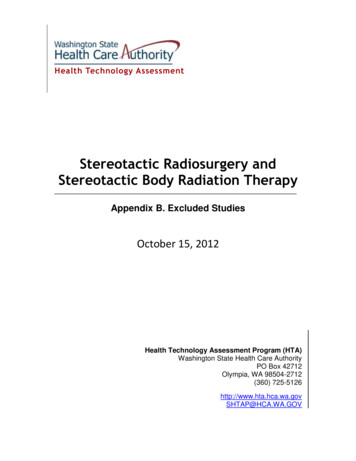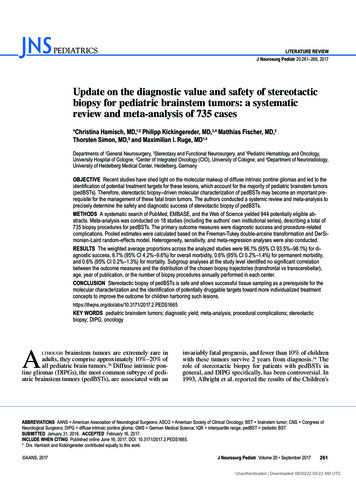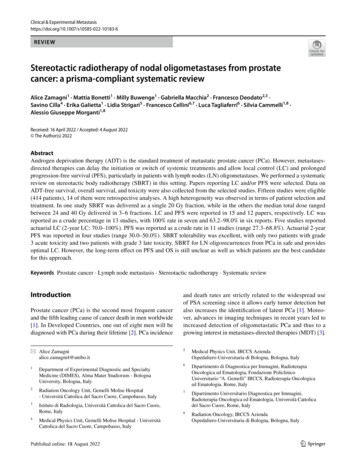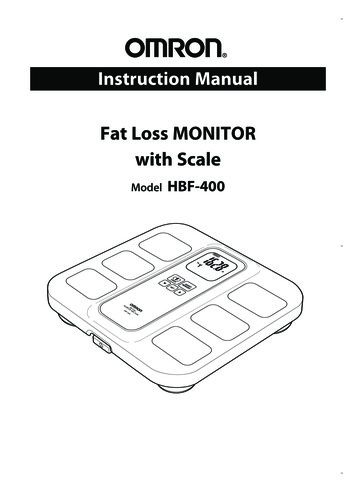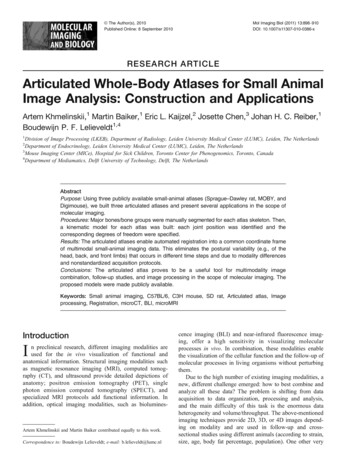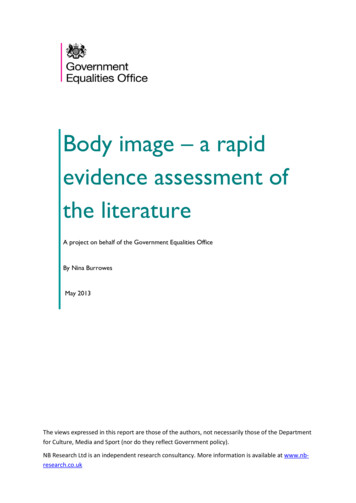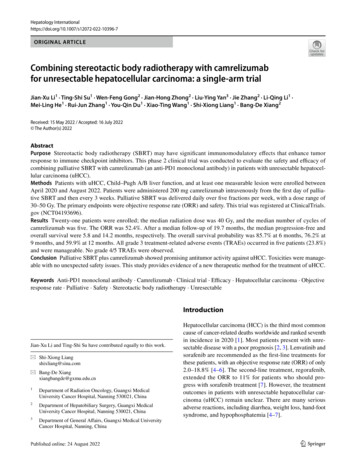
Transcription
Hepatology 396-7ORIGINAL ARTICLECombining stereotactic body radiotherapy with camrelizumabfor unresectable hepatocellular carcinoma: a single‑arm trialJian‑Xu Li1 · Ting‑Shi Su1 · Wen‑Feng Gong2 · Jian‑Hong Zhong2 · Liu‑Ying Yan3 · Jie Zhang2 · Li‑Qing Li1 ·Mei‑Ling He1 · Rui‑Jun Zhang1 · You‑Qin Du1 · Xiao‑Ting Wang1 · Shi‑Xiong Liang1 · Bang‑De Xiang2Received: 15 May 2022 / Accepted: 16 July 2022 The Author(s) 2022AbstractPurpose Stereotactic body radiotherapy (SBRT) may have significant immunomodulatory effects that enhance tumorresponse to immune checkpoint inhibitors. This phase 2 clinical trial was conducted to evaluate the safety and efficacy ofcombining palliative SBRT with camrelizumab (an anti-PD1 monoclonal antibody) in patients with unresectable hepatocellular carcinoma (uHCC).Methods Patients with uHCC, Child–Pugh A/B liver function, and at least one measurable lesion were enrolled betweenApril 2020 and August 2022. Patients were administered 200 mg camrelizumab intravenously from the first day of palliative SBRT and then every 3 weeks. Palliative SBRT was delivered daily over five fractions per week, with a dose range of30–50 Gy. The primary endpoints were objective response rate (ORR) and safety. This trial was registered at ClinicalTrials.gov (NCT04193696).Results Twenty-one patients were enrolled; the median radiation dose was 40 Gy, and the median number of cycles ofcamrelizumab was five. The ORR was 52.4%. After a median follow-up of 19.7 months, the median progression-free andoverall survival were 5.8 and 14.2 months, respectively. The overall survival probability was 85.7% at 6 months, 76.2% at9 months, and 59.9% at 12 months. All grade 3 treatment-related adverse events (TRAEs) occurred in five patients (23.8%)and were manageable. No grade 4/5 TRAEs were observed.Conclusion Palliative SBRT plus camrelizumab showed promising antitumor activity against uHCC. Toxicities were manageable with no unexpected safety issues. This study provides evidence of a new therapeutic method for the treatment of uHCC.Keywords Anti-PD1 monoclonal antibody · Camrelizumab · Clinical trial · Efficacy · Hepatocellular carcinoma · Objectiveresponse rate · Palliative · Safety · Stereotactic body radiotherapy · UnresectableIntroductionJian-Xu Li and Ting-Shi Su have contributed equally to this work.* Shi‑Xiong Liangshixliang@sina.com* Bang‑De Xiangxiangbangde@gxmu.edu.cn1Department of Radiation Oncology, Guangxi MedicalUniversity Cancer Hospital, Nanning 530021, China2Department of Hepatobiliary Surgery, Guangxi MedicalUniversity Cancer Hospital, Nanning 530021, China3Department of General Affairs, Guangxi Medical UniversityCancer Hospital, Nanning, ChinaHepatocellular carcinoma (HCC) is the third most commoncause of cancer-related deaths worldwide and ranked seventhin incidence in 2020 [1]. Most patients present with unresectable disease with a poor prognosis [2, 3]. Lenvatinib andsorafenib are recommended as the first-line treatments forthese patients, with an objective response rate (ORR) of only2.0–18.8% [4–6]. The second-line treatment, regorafenib,extended the ORR to 11% for patients who should progress with sorafenib treatment [7]. However, the treatmentoutcomes in patients with unresectable hepatocellular carcinoma (uHCC) remain unclear. There are many seriousadverse reactions, including diarrhea, weight loss, hand-footsyndrome, and hypophosphatemia [4–7].13Vol.:(0123456789)
Hepatology InternationalThe development of immune checkpoint inhibitors (ICIs)has opened a new era in the treatment of uHCC. The ORRwas 14–17% in pretreated uHCC patients treated withcamrelizumab, nivolumab, and pembrolizumab, which aremonoclonal antibodies against programmed cell death ligand1 (anti-PD1) [8–10]. With the rapid improvement in radiotherapy technology and equipment, the efficacy of radiotherapy for uHCC has significantly improved in recent years.The application of hypofractionated three-dimensional conformal radiotherapy (RT) in the treatment of HCC withoutextrahepatic metastasis can achieve an overall survival rateof 65% and 33% at 1 and 3 years, respectively [11]. Stereotactic body radiotherapy (SBRT) leads to better local controlwith a shorter treatment duration and fewer costs [12]. TheNational Comprehensive Cancer Network guidelines recommend RT as the standard treatment for uHCC [13].SBRT can promote the host antitumor immune responseand enhance the efficacy of cancer immunotherapy [14]. RTcombined with anti-PD1 enhanced the abscopal effect inC57BL/6 mice with HCC [15]. In recent years, RT combined with immunotherapy, as a new therapeutic method,has achieved certain efficacy in many cancers, such as nonsmall cell lung cancer [16], malignant pigmented tumor [17],and prostate cancer [18]. Theoretically, RT combined withanti-PD1 may also produce a synergistic antitumor effect onuHCC. We conducted this phase II clinical trial to evaluatethe safety and efficacy of combining palliative SBRT withcamrelizumab in patients with uHCC.Materials and methodsStudy design and patientsThe trial was an open-label, single-arm clinical study registered at ClinicalTrials.gov (NCT04193696). Writteninformed consent was obtained from all patients. The studywas performed according to the ethical guidelines of theDeclaration of Helsinki and was approved by the EthicsCommittee of Guangxi Medical University Cancer Hospital (KS2019(209)).Patients were recruited on-site by clinic staff. Datawere collected from the electronic charting system ofthe hospital and patient follow-ups. Eligible patientswere 18–70 years of age and had uHCC. All diagnoseswere confirmed histologically, cytologically, or clinically based on the American Association for the Studyof Liver Diseases criteria [19]. Patients had an Eastern Cooperative Oncology Group performance status(ECOG PS) of 0 or 1 and at least one measurable lesionaccording to the modified Response Evaluation Criteriain Solid Tumors (mRECIST) [20] and version 1.1 of theResponse Evaluation Criteria in Solid Tumors (RECIST13v1.1) [21], with Barcelona Clinic Liver Cancer (BCLC)stage B or C classification and Child–Pugh class A or Bscale. The patients had previously failed or relapsed afterreceiving therapy other than immunotherapy checkpointinhibitors, had stopped using them for more than 20 daysprior to baseline screening, and had previously receivedregional treatment for HCC (including radiofrequencyablation, percutaneous ethanol or acetic acid injection,cryotherapy, high-intensity focused ultrasound, hepaticarterial chemoembolization, and hepatic arterial embolization) with definite progression in the local treatmentarea according to RECIST v1.1. All patients had adequateliver function (bilirubin 1.5 times the upper limit ofnormal (ULN), and aspartate aminotransferase (AST) andalanine aminotransferase (ALT) 3 times ULN), hemoglobin 90 g/L, platelet count 60 109/L, and absoluteneutrophil count 1.5 109/L. The key exclusion criteria were history of immunotherapy, RT within 6 monthsbefore the first administration, active autoimmune diseasesrequiring systemic treatment, and active infections.TreatmentAll patients underwent computed tomography (CT) scansfor SBRT planning, and the images were acquired at a2.5–5 mm slice thickness in free quiet breathing mode.Vacuum body cushions and thermoplastic body maskswere used for patient immobilization. All the target volumes and organs at risk (OARs) were contoured in theMIM 6.8 system; gross target volume (GTV) was determined by imaging examinations. CT-magnetic resonanceimaging (MRI) fusion for lesions in the liver and CT-positron emission tomography (PET-CT) fusion for extrahepatic lesions were performed to clearly show the lesion.For patients with multiple lesions, as many lesions as possible were chosen for SBRT if tolerated at the discretionof the radiation oncologists. The GTV was expanded to5–10 mm to establish the planning GTV (PGTV). Thepalliative radiation dose to PGTV ranged from 30–50 Gyin 10 fractions. The SBRT plans were designed usingthe Monaco treatment planning system version 5.1 andperformed using volumetric-modulated arc therapy. TheOARs were the priority constraints on PGTV for treatmentplanning. Palliative SBRT was delivered daily over fivefractions per week using a 6 MV X-ray linear accelerator(ELEKTA Versa-HD). Cone-beam CT images were usedto correct the positions.The camrelizumab regimen, including dose, method ofinjection, and duration of treatment, was developed according to the RESCUE trial [22] and the guideline provided bythe manufacturer. Briefly patients were administered 200 mgcamrelizumab intravenously over 30 min from the first day
Hepatology Internationalof SBRT and then every 3 weeks until disease progression orintolerable toxicity. Camrelizumab could be delayed for upto 12 weeks throughout the study, but the dose could not beadjusted. Patients whose disease had progressed were permitted to continue camrelizumab if the researchers judgedthat they would benefit from and tolerate treatment.26 patients with unresectable HCC screenedbetween April 2020 and August 2021Excluded (N 5)Ineligible (N 2)Withdrew consent (N 2)Combined with ICC (N 1)Evaluation of efficacy and safetyRECIST v1.1 and mRECIST were used to evaluate tumorresponses in target and nontarget lesions by two investigators. The first imaging evaluation was performed during thethird camrelizumab session at about 6 weeks after the startof SBRT, the second one at about 12 weeks after SBRT, andthen every 3 months. The primary endpoint was safety, andthe ORR was defined as the sum rate of complete remission (CR) and partial remission (PR). The secondary endpoints were overall survival (OS) measured from the day ofinformed consent to the day of death; progression-free survival (PFS), defined as the time from informed consent untildisease progression or death; and disease control, defined asthe sum of CR PR stable disease (SD). All participantswere followed up monthly for progression and survival status. All adverse events (AEs) and treatment-related adverseevents (TRAEs) were recorded from the first SBRT until90 days after the last camrelizumab injection, according tothe Common Terminology Criteria for Adverse Events ofthe National Cancer Institute v5.0.Statistical analysisAssuming an ORR in 50% of patients treated with combination of SBRT and camrelizumab, 21 patients could provide80% power to ensure the lower boundary and 0.05 alpha toreject a true null hypothesis in a one-sample exact binomialtest at the significance level of 0.05 vs. 18.8% treated withlenvatinib. We conducted sample size statistical analysesusing the PASS v15 software (NCSS, Kaysville, UT, USA).Baseline demographic and clinical characteristics arepresented as mean standard deviation, median (range), orN (%). The ORR and disease control rate (DCR) were calculated with 95% confidence intervals (CI) using the Clopper–Pearson method. PFS, time to response rate (TTR),and OS were estimated using the Kaplan–Meier method.TTR was analyzed in patients with a confirmed CR or PR.The duration of follow-up was calculated using the reverseKaplan–Meier estimate of OS. All statistical analyses wereperformed using IBM SPSS software (ver. 26.0 SPSS Inc.,Chicago, IL, USA).21 patients underwent radiotherapy plus camrelizumab21 patients included into analysisFig. 1 Patient selection flow. HCC hepatocellular carcinoma, ICCintrahepatic cholangiocarcinomaResultsPatients and treatmentFrom April 3, 2020 to January 21, 2021, 26 patients werescreened for eligibility (Fig. 1), and 21 patients were enrolledin the study (the analysis set). At the cutoff date (May 1,2022), the median follow-up of all patients in the analysis setwas 19.7 months (95% CI 17.4–22.0), and patients receiveda median of 5 (range 2–27) cycles of camrelizumab. All21 patients with more than 78 lesions (one patient with toomany uncountable pulmonary metastases was counted as4, and four patients with more than 3 lesions were countedas 4) received palliative SBRT for 45 lesions including 24intrahepatic lesions and 21 extrahepatic lesions. Due to thehigh costs of the treatment, 3 of the 4 patients with SD asbest response did not continue camrelizumab, along with 7of the 10 patients with PR as best response by RECIST v1.1.After disease progression, of all the patients, 4 with ECOGPS 0–1 and without taboos refused any subsequent treatment, 1 underwent palliative surgical resection, 1 receivedsorafinib, 3 received apatinib, and 5 received lenvatinib.As shown in Table 1, the ages of the participants rangedfrom 31 to 69 years, with a median age of 54 years, and amale probability of 90.5%. Twenty patients were diagnosedwith BCLC-C and one with BCLC-B, with 85.7% havingchronic hepatitis B virus (HBV) etiology and 52.4% presenting with radiographic liver cirrhosis. Up to 19 patients(90.5%) had multiple lesions, including 10 (47.6%) withmore than or equal to 4 lesions, and 10 (47.6%) had receivedtwo or more lines of previous treatments. Among those 3patients (14.3%) who had undergone previous systemictherapy, 2 received sorafenib and 1 received apatinib beforethe trial.13
Hepatology InternationalTable 1 Baseline demographic and clinical characteristicsCharacteristicValueSex, maleAge, yearHepatitis B virus infection, presentLiver cirrhosis, presentECOG PS01Total bilirubin, μmol/LAlbumin (g/L)Child–Pugh gradeABALBI grade123Alpha fetoprotein, 400 ng/mlMaximum tumor size, (cm)Tumor number123 4Macrovascular invasion, presentExtrahepatic metastasis, presentBCLC stageBCDose (Gy)Gross tumor volume, (ml)Prior therapyTACEHepatectomyRFASystemic therapy19 (90.5)54 (31–69)18 (85.7)11 (52.4)14 (66.7)7 (34.3)15.3 4.436.9 (24.8–41.6)20 (95.2)1 (4.8)5 (23.8)15 (71.4)1 (4.8)10 (47.6)7.0 4.02 (9.5)6 (28.6)3 (14.3)10 (47.6)10 (47.6)14 (66.7)1 (4.8)20 (95.2)40 (30–50)205 (11–1471)9 (42.9)16 (76.2)6 (28.6)3 (14.3)Data are mean standard deviation, median (range) or N (%)ALBI the Albumin-Bilirubin grade, BCLC Barcelona Clinic LiverCancer, ECOG PS Eastern Cooperative Oncology Group performance status, RFA radiofrequency ablation, TACE trans-arterialchemoembolizationEfficacyA summary of efficacy outcomes after a median follow-upof 19.7 months is shown in Table 2. The ORR was 52.4%according to RECIST v1.1 and mRECIST. CR was observedin one patient (4.8%) according to RECIST v1.1 and twopatients (9.5%) according to mRECIST. PR was observed in10 patients (47.6%) according to RECIST v1.1 and 9 patients(42.9%) according to mRECIST. Fourteen patients (66.7%)13achieved disease control according to the RECIST 1.1and mRECIST. The median OS was 14.2 months (95% CI7.2–21.2, Fig. 2a, Table 2). The OS probability was 85.7%(95% CI 62.0–95.2) at 6 months, 76.2% (95% CI 51.9–89.3)at 9 months, and 59.9% (95% CI 35.3–77.7) at 12 months.The median PFS was 5.8 months (95% CI 4.2–7.4, Fig. 2b,Table 2). For the other secondary efficacy endpoints, themedian time to response was 2.1 months (95% CI 1.9–2.3).For the 20 patients with BCLC stage C disease, after amedian follow-up of 19.4 months, the ORR was 55.5%, themedian OS was 17.4 months (95% CI 7.3–27.5, Fig. 2c,Supplemental Table 1) and the median PFS was 5.8 months(95% CI 5.4–6.2, Fig. 2d, Supplemental Table 1).The rate of shrinkage of the tumor target lesion isshown by a waterfall plot. Seventeen patients (81.0%)achieved 30% tumor target lesion shrinkage accordingto RECIST v1.1 (Fig. 3a) and mRECIST (Fig. 3b) frombaseline at one or more radiographic evaluation time pointsduring the entire treatment period. Eighteen (85.7%) and20 (95.2%) patients achieved tumor target lesion shrinkagefrom baseline according to RECIST v1.1 and mRECIST,respectively.One patient (5.3%) with multiple lymph nodes and peritoneal metastases exhibited hyperprogression of the targetlesions, and extensive serious malignant hemorrhagic pleural effusion and new target lesions appeared. He developeda continuous fever and died 2.8 months after enrollmentbecause of tumor progression.SafetyAll TRAEs of any grade are summarized in Table 3. Themost common TRAEs of any grade were reactive cutaneouscapillary endothelial proliferation (RCCEP) in 17 patients(81.0%), decreased white blood cell count in 16 (76.2%),decreased hemoglobin in 14 (66.7%), decreased neutrophil count in 13 (61.9%), decreased albumin in 11 (52.4%),increased AST in 11 (52.4%), increased ALT in 10 (47.6%),and asthenia in 10 (47.6%).Grade 3 treatment-related AEs occurred in fivepatients (23.8%), including decreased hemoglobin in twopatients, decreased neutrophil count in one, increasedγ-glutamyltransferase in one, and decreased platelet countin one. Grade 4 or 5 TRAEs were not observed. The adverseevents are summarized in Supplemental Table 2. Briefly,more than TRAEs, one patient presented with a grade twofood allergy, and one with grade three esophageal and gastric variceal bleeding. Serious AEs were reported in twopatients, namely treatment-related decreased platelet countin one and esophageal and gastric variceal bleeding anddecreased platelet count in another, who had severe varicoseesophagogastric fundus veins at enrollment.
Hepatology InternationalTable 2 Summary of efficacyoutcomes (N 21)OutcomesRECIST1.1mRECISTObjective responseDisease controlBest overall responseCRPRSDPDProgression-free survival, median months (95% CI)Overall survival, %6 months, (95% CI)9 months, (95% CI)12 months, (95% CI)Median overall survival time, months (95% CI)Time to response, median months (95% CI)11 (52.4)14 (66.7)11 (52.4)14 (66.7)1 (4.8)10 (47.6)3 (14.3)7 (33.3)5.8 (4.2–7.4)2 (9.5)9 (42.9)3 (14.3)7 (33.3)85.7 (62.0–95.2)76.2 (51.9–89.3)59.9 (35.3–77.7)14.2 (7.2–21.2)2.1 (1.9–2.3)Data are N (%, or 95% CI), unless indicatedCR complete response, PD progressive disease, PR partial response, SD stable diseaseFig. 2 Kaplan–Meier analysis of overall and progression-free survival. a Overall and b progression-free survival for all patients, c overall and dprogression-free survival for patients with Barcelona Clinic Liver Cancer stage C disease13
Hepatology InternationalFig. 3 Best percentage change from baseline in sums of diameters of target lesions by RECIST 1.1 (a) and mRECIST (b). CR completeresponse, PR partial response, SD stable disease, PD progressive diseaseTable 3 Treatment-relatedadverse eventsAdverse eventsAny gradeGrade 1Grade 2Grade 3All eventsSerious eventsEvents leading to discontinuationRCCEPDecreased white blood cellDecreased hemoglobinDecreased neutrophil countDecreased albuminIncreased ASTAstheniaIncreased ALTIncreased γ-glutamyltransferaseNauseaDecreased platelet countIncreased blood sed ALP19 (90.5)1 (4.8)4 (19.1)17 (81.0)16 (76.2)14 (66.7)13 (61.9)11 (52.4)11 (52.4)10 (47.6)10 (47.6)7 (33.3)5 (23.8)4 (19.1)4 (19.1)4 (19.1)2 (9.5)2 (9.5)1 (4.8)1 (4.8)19 (90.5)0 (0)0 (0)15 (71.5)7 (33.3)8 (38.1)9 (42.9)7 (33.3)10 (47.6)10 (47.6)8 (38.1)6 (28.6)5 (23.8)0 (0)2 (9.5)4 (19.1)2 (9.5))2 (9.5)0 (0)0 (0)16 (76.2)0 (0)3 (14.3)2 (9.5)9 (42.9)4 (19.1)3 (14.3)4 (19.1)1 (4.8)0 (0)2 (9.5)0 (0)0 (0)3 (14.3)2 (9.5)0 (0)0 (0)0 (0)1 (4.8)1 (4.8)5 (23.8)1 (4.8)1 (4.8)0 (0)0 (0)2 (9.5)1 (4.8)0 (0)0 (0)0 (0)0 (0)1 (4.8)0 (0)1 (4.8)0 (0)0 (0)0 (0)0 (0)0 (0)0 (0)Data are N (%)ALP alkaline phosphatase, ALT alanine aminotransferase, AST aspartate aminotransferase, RCCEP reactivecutaneous capillary endothelial proliferationDiscussionTo our knowledge, few prospective clinical trials havereported the safety and efficacy of combining anti-PD1with SBRT for patients with uHCC. It should be noted that,as shown in Table 1, most patients enrolled in the studyhad advanced stage disease (95.2% BCLC-C), large tumorburden, high AFP values, and were refractory to multiple13prior line therapies with dismal prognosis. The combinationtreatment was safe and well tolerated, and promising antitumor activity was observed. Combining anti-PD1 therapywith SBRT might be a potential strategy to efficiently treatpatients with uHCC.Qin et al. (2020) reported that Chinese patients withsimilar baseline demographic and clinical characteristicsreceived camrelizumab treatment. The ORR was 14.7%,and the median PFS was 2.1 months [8]. Camrelizumab has
Hepatology Internationalshown remarkable antitumor activity in patients with uHCC.In our study, the ORR (52.7% vs. 14.7%) and PFS (5.8 vs2.1 months) were much better. Furthermore, in our study,CR was observed in one patient (4.8%) according to RECISTv1.1 and in two patients (9.5%) according to mRECIST.Fourteen patients (66.7%) achieved disease control according to the RECIST v1.1 and mRECIST. Compared withcamrelizumab alone, OS probability with the combinationtreatment was 85.7% vs. 74.4% at 6 months, 76.2% vs. 64.0%at 9 months, and 59.9% vs. 55.9% at 12 months, revealingthe therapeutic efficacy of combining anti-PD1 with SBRT.It is worth noting that 10 patients (71.4%) with disease control as the best response received 5 cycles of camrelizumaband did not continue treatment, and 4 with ECOG PS 0–1and without taboos after disease progression refused anysubsequent treatment, which may be an important reasonfor the decline in the efficacy of combining anti-PD1 withSBRT for uHCC. The efficacy of radiotherapy for uHCC hasimproved significantly in recent years. Eleni Gkika. reportedthat the median OS in the treatment of uHCC was 9 months(95% CI 7.7–10.3) [23]. For BCLC-C patients in SouthKorea, the median OS in the RT group was significantlylonger than that in the sorafenib group (7.6 vs 3.8 months,p 0.001) [24]. In this study, the median OS was significantly longer than that observed with SBRT alone. The combination of anti-PD1 and SBRT achieved better antitumoreffects than anti-PD1 or SBRT alone in uHCC patients. Thisis mainly attributed to the phenomenon that non-targeteddistant tumors were downsized following RT, known as the“abscopal effect” [25]. RT can gradually cause immunogenicdeath, such as cell death, which effectively exposes tumorantigens and triggers an immune response throughout thecourse and several months after RT [26]. RT can reprogramthe tumor microenvironment by inducing chemokines andpromoting dendritic cell maturation involved in the recruitment of effector T cells. Antigen-educated T cells can homenot only into the irradiated but also non-irradiated tumordeposits, and may cause tumor regression [27]. Adding RTto ICI increases the clinical benefit in non-irradiated tumorsites in patients with HCC [28].Sorafenib is recommended as a first-line treatmentfor patients with uHCC. The median OS in the sorafenibgroup was only 6.5 months, and the ORR was only 3.3%in Asia–Pacific uHCC patients with 70.7% HBV infection[6]. In our study, all patients were from China, and 85.7%had a chronic HBV etiology, indicating that they weremore prone to develop progressive disease and had poorerprognoses [29]. Other baseline demographic and clinicalcharacteristics were similar. Their clinical outcomes weresignificantly better than those treated with sorafenib. TheREFELECT study showed that lenvatinib was not inferiorto sorafenib in untreated patients with uHCC. The ORRin the lenvatinib arm was 18.8% by RECIST v1.1, basedon a masked independent imaging review, and that in thesorafenib arm was 6.5% [5]. Better ORR was observed inour study, although most patients were refractory to multiple prior line therapies with dismal prognosis and highrates of chronic HBV infection, meaning that they were moreprone to develop progressive disease and had poorer prognoses than those with hepatitis c virus [29, 30]. Combiningatezolizumab with bevacizumab improved the efficacy ofsystemic therapy for uHCC, and the patients had an ORR of27.3% according to independent assessment with RECISTv1.1 in the IMbrave150 trial [31]. Combining anti-PD1 withSBRT achieved better ORR and similar survival probabilities at 6 months (85.7% vs. 84.8%) and 12 months (59.9%vs. 67.2%). It should be noted that the patients with BCLCA and B accounted for 17% in the IMbrave150 trial, whichis much higher than that in our study (4.8%), and a largeproportion of patients without progressive disease failed toremain on camrelizumab. Meanwhile, treatment with atezolizumab plus bevacizumab was too expensive.As up to 95.2% of patients in this study had BCLC-C, thesubgroup data were analyzed. The median OS with BCLCC was 17.4 months in this study and 5.6 months for theAsia–Pacific patients receiving sorafenib [6]. For the subgroup BCLC-C analysis, the REFELECT study showed themedian OS was 11.8 months in the lenvatinib group and10.3 months in the sorafenib group [5]. This study revealedthat the combination of camrelizumab with SBRT showedpromising antitumor activity in patients with BCLC-C HCC.In this study, there were no new or unexpected toxicities resulting from the SBRT plus camrelizumab combination therapy. Grade 3 TRAEs occurred in five patients(23.8%), including two with decreased hemoglobin, onewith decreased neutrophil count, one with increasedγ-glutamyltransferase, and one with decreased plateletcount. The safety of SBRT plus camrelizumab combination therapy in this population was consistent with that ofcamrelizumab or SBRT alone in previously reported studies[8, 12, 23]. The occurrence rate of grade 3 TRAEs wasless than 57% in patients treated with lenvatinib and 49%in patients treated with sorafenib reported in REFLECT[5], and 56.5% in patients treated with atezolizumab plusbevacizumab reported in IMbrave150 [31]. Serious AEswere reported in two patients (9.5%), including one patientwith non-treatment-related esophageal and gastric varicealbleeding. Considering that this patient had severe varicoseesophagogastric fundus veins at enrollment, we believe thatthe serious AEs were not treatment-related side effects.This study has several limitations. First, the small sample size and nature of this single-arm study were the mainlimitations. Therefore, the results presented herein shouldbe regarded as preliminary, requiring a larger sample sizeand phase 3 clinical studies for confirmation. Second, as itwas not mandatory for patients to provide tumor samples,13
Hepatology Internationalthe lack of samples for PD-1/PD-L1 detection could be considered a limitation. Third, the patients could not continuecamrelizumab because they could not afford it. However, inthis case, promising antitumor activity was observed.In conclusion, the results of this study demonstrated anacceptable safety profile of combining camrelizumab withSBRT for patients with uHCC. Despite the small samplesize, we observed preliminary antitumor activity, especiallyin BCLC-C HCC. Combination treatment has several advantages over other recommended treatments: it incurs less cost,produces less grade 3 TRAEs, and is easier to accomplishthan other treatments while having similar or better antitumor activity. This study provides evidence for a new therapeutic method that combines camrelizumab with SBRT forthe treatment of uHCC.Supplementary Information The online version contains supplementary material available at https://d oi.o rg/1 0.1 007/s 12072-0 22-1 0396-7.Acknowledgements We wish to thank all patients involved in thisstudy, the investigators and our colleagues at Guangxi Medical University Cancer Hospital.Author contributions SXL and BDX conceived and designed the study.JXL, TSS, WFG, JHZ and JZ enrolled patients. JXL, LYY, MLH, RJZ,YQD, WXT collected the data. JXL, TSS and LQL analyzed the data.JXL and TSS assessed tumor response; JXL drafted the manuscript.All authors read and approved the final manuscript.Funding This study was funded by the Development and ApplicationProject for the Appropriate Technology of Health of Guangxi Province(S2019039), the Self-Raised Scientific Research Fund of the Ministryof Health of Guangxi Province (Z20201371), Jiangsu Hengrui Pharmaceuticals Co., Ltd., Shanghai, China and the Youth Program of Scientific Research Foundation of Guangxi Medical University CancerHospital (2021-10).Data availability The data underlying this article will be shared onreasonable request to the corresponding author.DeclarationsConflict of interest Jian-Xu Li, Ting-Shi Su, Wen-Feng Gong, Jian‑Hong Zhong, Liu-Ying Yan, Jie Zhang, Li‑Qing Li, Mei-Ling He,Rui-Jun Zhang, You-Qin Du, Xiao-Ting Wang, Shi-Xiong Liang, andBang-De Xiang have no conflict of interest to declare that are relevantto the content of this article.Ethical approval The study was performed according to the ethicalguidelines of the Declaration of Helsinki and was approved by theEthics Committee of Guangxi Medical University Cancer Hospital(KS2019(209)).Consent to participate Written informed consent was obtained fromall patients.Consent for publication Written informed consent for publication wasobtained from all participants.13Open Access This article is licensed under a Creative Commons Attribution 4.0 International License, which permits use, sharing, adaptation, distribution and reproduction in any medium or format, as longas you give appropriate credit to the original author(s) and the source,provide a link to the Creative Commons licence, and indicate if changeswere made. The images or other third party material in this article areincluded in the article's Creative Commons licence, unless indicatedotherwise in a credit line to the material. If material is not included inthe article's Creative Commons licence and your intended use is notpermitted by statutory regulation or exceeds the permitted use, you willneed to obtain permission directly from the copyright holder. To view acopy of this licence, visit http:// creat iveco mmons. org/ licen ses/ by/4. 0/.References1. Siegel RL, Miller KD, Jemal A. Cancer statistics, 2020. CA Cancer J Clin. 2020;70(1):7–302. Schöniger-Hekele M, Müller C, Kutilek M, Oesterreicher C, Ferenci P, Gangl A. Hepatocellular carcinoma in Central Europe:prognostic features
v1.1 in the IMbrave150 trial [31]. Combining anti-PD1 with SBRT achieved better ORR and similar survival probabili-ties at 6 months (85.7% vs. 84.8%) and 12 months (59.9% vs. 67.2%). It should be noted that the patients with BCLC-A and B accounted for 17% in the IMbrave150 trial, which is much higher than that in our study (4.8%), and a large
